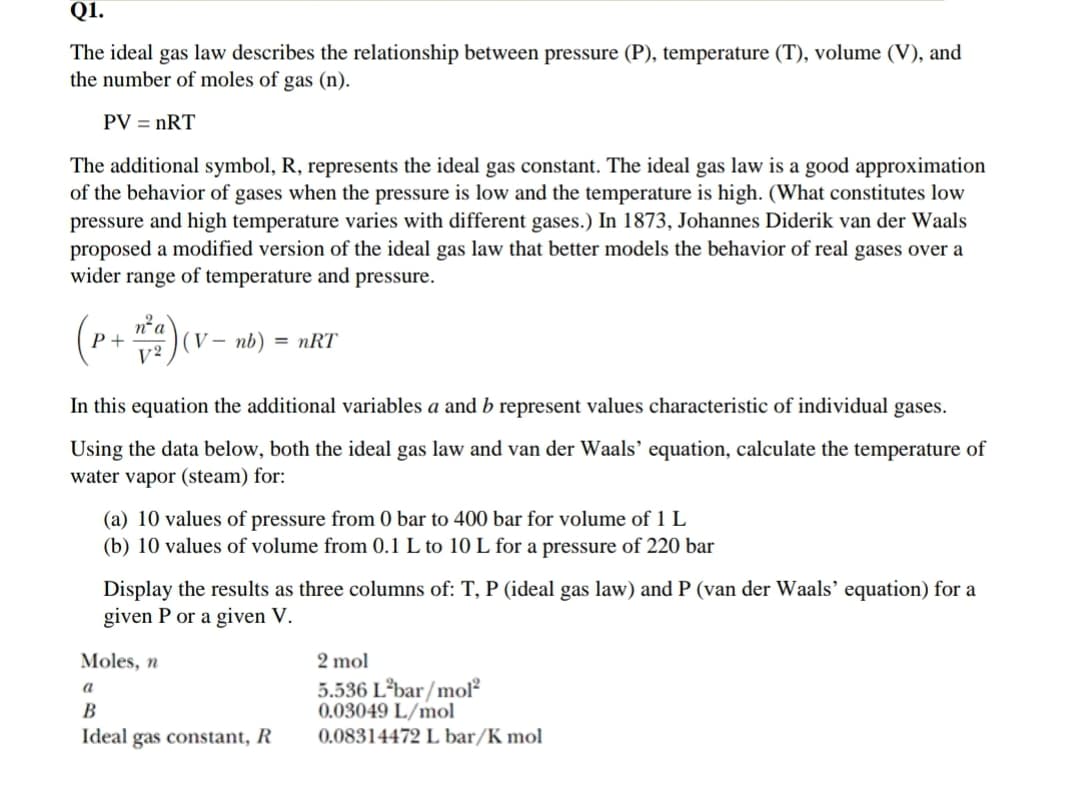The ideal gas law describes the relationship between pressure (P), temperature (T), volume (V), and the number of moles of gas (n). PV = nRT The additional symbol, R, represents the ideal gas constant. The ideal gas law is a good approximation of the behavior of gases when the pressure is low and the temperature is high. (What constitutes low pressure and high temperature varies with different gases.) In 1873, Johannes Diderik van der Waals proposed a modified version of the ideal gas law that better models the behavior of real gases over a wider range of temperature and pressure. na P + ")(v – nb) = nRT In this equation the additional variables a and b represent values characteristic of individual gases.
The ideal gas law describes the relationship between pressure (P), temperature (T), volume (V), and the number of moles of gas (n). PV = nRT The additional symbol, R, represents the ideal gas constant. The ideal gas law is a good approximation of the behavior of gases when the pressure is low and the temperature is high. (What constitutes low pressure and high temperature varies with different gases.) In 1873, Johannes Diderik van der Waals proposed a modified version of the ideal gas law that better models the behavior of real gases over a wider range of temperature and pressure. na P + ")(v – nb) = nRT In this equation the additional variables a and b represent values characteristic of individual gases.
Chemistry for Engineering Students
4th Edition
ISBN:9781337398909
Author:Lawrence S. Brown, Tom Holme
Publisher:Lawrence S. Brown, Tom Holme
Chapter5: Gases
Section: Chapter Questions
Problem 5.98PAE
Related questions
Question

Transcribed Image Text:The ideal gas law describes the relationship between pressure (P), temperature (T), volume (V), and
the number of moles of gas (n).
PV = nRT
The additional symbol, R, represents the ideal gas constant. The ideal gas law is a good approximation
of the behavior of gases when the pressure is low and the temperature is high. (What constitutes low
pressure and high temperature varies with different gases.) In 1873, Johannes Diderik van der Waals
proposed a modified version of the ideal gas law that better models the behavior of real gases over a
wider range of temperature and pressure.
na
P +
")(v – nb) = nRT
In this equation the additional variables a and b represent values characteristic of individual gases.
Expert Solution
This question has been solved!
Explore an expertly crafted, step-by-step solution for a thorough understanding of key concepts.
This is a popular solution!
Trending now
This is a popular solution!
Step by step
Solved in 5 steps

Knowledge Booster
Learn more about
Need a deep-dive on the concept behind this application? Look no further. Learn more about this topic, chemistry and related others by exploring similar questions and additional content below.Recommended textbooks for you

Chemistry for Engineering Students
Chemistry
ISBN:
9781337398909
Author:
Lawrence S. Brown, Tom Holme
Publisher:
Cengage Learning

Introductory Chemistry: A Foundation
Chemistry
ISBN:
9781337399425
Author:
Steven S. Zumdahl, Donald J. DeCoste
Publisher:
Cengage Learning

Chemistry & Chemical Reactivity
Chemistry
ISBN:
9781337399074
Author:
John C. Kotz, Paul M. Treichel, John Townsend, David Treichel
Publisher:
Cengage Learning

Chemistry for Engineering Students
Chemistry
ISBN:
9781337398909
Author:
Lawrence S. Brown, Tom Holme
Publisher:
Cengage Learning

Introductory Chemistry: A Foundation
Chemistry
ISBN:
9781337399425
Author:
Steven S. Zumdahl, Donald J. DeCoste
Publisher:
Cengage Learning

Chemistry & Chemical Reactivity
Chemistry
ISBN:
9781337399074
Author:
John C. Kotz, Paul M. Treichel, John Townsend, David Treichel
Publisher:
Cengage Learning

Chemistry & Chemical Reactivity
Chemistry
ISBN:
9781133949640
Author:
John C. Kotz, Paul M. Treichel, John Townsend, David Treichel
Publisher:
Cengage Learning

Introduction to General, Organic and Biochemistry
Chemistry
ISBN:
9781285869759
Author:
Frederick A. Bettelheim, William H. Brown, Mary K. Campbell, Shawn O. Farrell, Omar Torres
Publisher:
Cengage Learning

Chemistry
Chemistry
ISBN:
9781305957404
Author:
Steven S. Zumdahl, Susan A. Zumdahl, Donald J. DeCoste
Publisher:
Cengage Learning